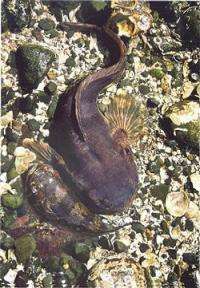Listening to the song of the toadfish (w/Audio)

(PhysOrg.com) -- Professor Roger Bland is listening in on one of the noisier creatures in San Francisco Bay, using physics to analyze the mating song of the toadfish. While fish don't have vocal chords, they have innovative ways of producing sound. The toadfish, or plainfin midshipman as it is sometimes called because of its button-like markings, is known for its vociferous nighttime mating call. During the summer mating season, the toadfish enter the bay and the male toadfish vibrate the muscles of their swim bladder to invite females to their nests on the bottom of the bay.
What interests Bland, a professor of physics, is that his recordings suggest cooperative behavior among the toadfish. "The toadfish seem to be collaborating in their calling," Bland said. "Individuals near each other seem to adjust their frequency, or pitch, to an approximate common value. Like a choir improvising, the group's pitch swings substantially over several hours with the individual fish following the swings, indicating that they are listening to each other and responding."
Bland plans to conduct further research on toadfish calls, applying complex physics equations to analyze the fish's pitch. He is also interested in how location affects pitch. "What we are hearing is that one community of toadfish sings at a different pitch to those in the next neighborhood," Bland said.
Since last spring, Bland has been collecting continuous underwater recordings from a microphone based at the Romberg Tiburon Center for Environmental Studies. It is the first permanent acoustic recording station in the bay. The hydrophone, an underwater microphone, is mounted at the end of the Center's pier, extending approximately 200 feet from the seawall into water about 40 feet deep.
Bland and his students convert the sound files into spectrograms, graphs that plot frequency (pitch) against time. "When we hear the toadfish chorus tuning up, the spectrogram shows colored lines from the different fish coming together, like weaving a yarn from several strands," Bland said.
Capturing clear recordings is a challenge due to noise pollution from ship traffic, which often has a frequency similar to the sounds made by sea life, making it difficult to separate the two. Bland is planning to collaborate with Romberg Tiburon Center researchers to investigate the effect that noise pollution from ships in San Francisco Bay has on communication among toadfish.
Provided by San Francisco State University (news : web)

















